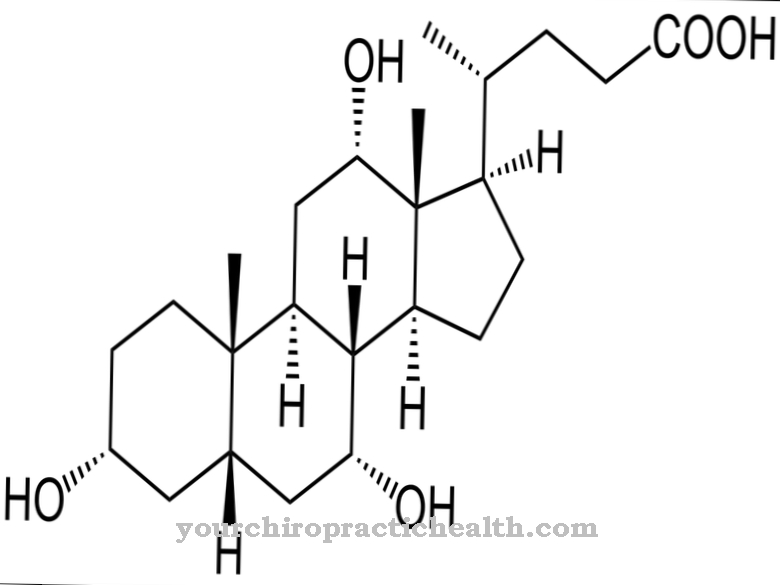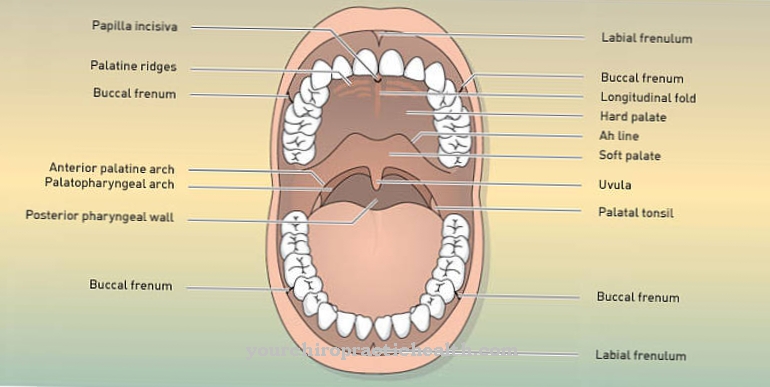The Ascending palatine artery branches off from the facial artery (arteria facialis).Its task is to supply the tonsils (tonsilla palatina) as well as the soft palate (pallatum molle) and the palatal glands (glandulae palatinae) with oxygen-rich blood.
What is the ascending palatine artery?
The ascending palatine artery is a branch of the facial artery (arteria facialis). This belongs to the human body cycle.
The ascending palatine artery runs in the head and bears the name ascending palatal arteryas it extends to this area of the oral cavity. Before that, it follows the course of the throat. The arterial counterpart to the ascending palatine artery is the descending palatine artery. It has its origin in the maxillary artery or mandibular artery and belongs to its pterygopalatinal branches (pars pterygopalatina).
The blood of the ascending palatine artery is relatively rich in oxygen because it comes from the lungs. There, oxygen molecules accumulate on the red blood cells (erythrocytes) and reach various tissues and organs via the various vessels of the great blood circulation. The oxygen-poor blood then flows back to the lungs via veins.
Anatomy & structure
The ascending palatine artery has its origin in the facial artery. It represents the first of the facial branches and is one of the cervical branches.
Other arteries that also originate from the facial artery and belong to this group are the tonsil ramus (almond branch), the glandular branch (salivary gland branch), the submental artery (lower chin artery) and the muscular rami (muscular branches). In addition, the facial artery has five facial branches.
After the ascending palatine artery branches off from the facial artery, it extends to the throat (pharynx) and follows it. The arterial blood divides into the two branches of the vein. From the soft palate lifter (Musculus levator veli palatini) one of the branches runs through the upper pharyngeal constrictor (Musculus constrictor pharyngis superior) and reaches the tonsil (Tonsilla palatina). The other branch also begins on the soft palate, but then extends over the upper pharynx to the soft palate (pallatum molle). Then the ascending palatine artery and the descending palatine artery connect in a so-called anastomosis.
Function & tasks
With its two branches, the ascending palatine artery supplies the palatine tonsil (tonsilla palatina) and the soft palate (pallatum molle), as well as the palatal glands (glandulae palatinae). The palatine tonsil is an anatomical structure of the oral cavity, which is located in the tonsillar bay (fossa tonsillaris). The palatine tonsil forms an organ of the lymphatic system. The lymphatic system, in turn, is part of the immune system and, as such, is responsible for combating pathogens. Within the lymphatic system, the tonsil is one of the secondary lymphatic organs.
The soft palate represents the back part of the palate, while the anatomy also calls the front part the hard palate. The soft palate is made up of the soft palate (velum palatinum) and the uvula. Both the soft palate and the uvula have the task of preventing food from entering the nose when swallowed. They are also important for the formation of certain sounds. In addition to the ascending palatine artery, the descending palatine artery and the ascending pharyngeal artery are also responsible for the blood supply to the palate.
In addition, the palatal glands are dependent on the oxygen-rich blood from the ascending palatine artery. The palatal glands or glandulae palatinae are not only located in the soft palate, but also in the back of the hard palate. They produce a secretion that keeps the skin of the palate moist and contains enzymes that help digest food. The palatine glands are one of the small salivary glands - the three large salivary glands are the parotid gland (glandula parotidea), the submandibular gland (submandibular gland) and the sublingual gland (sublingual gland).
Diseases
Various vascular diseases can manifest themselves in the ascending palatine artery. An example of this is the aneurysm, in which the vessel wall of the artery overstretched. This creates a pouch that makes the arterial wall thinner.
The increased instability of the blood vessel can lead to rupture of the artery. As a result, there is an undersupply in the tissues that rely on the oxygen-rich blood of the artery. Blood clots can also form inside an aneurysm. The clots, also known as thrombi, are caused by the clotting properties of the blood and can develop without any noticeable symptoms.
However, if such a thrombus loosens, it can get caught in a thinner part of the artery and cause partial or complete occlusion. Medicine also calls this occlusion an embolism. In some cases, it may manifest as a sharp pain in the affected area. However, an embolism is not always due to a thrombus. Other potential causes include fat, undissolved gas, calcium, connective tissue, and even foreign objects getting into the blood.
External influences can also damage the ascending palatine artery, for example in the context of fractures in the head and face area, which typically affect several types of tissue. Causes of such fractures include accidents involving head involvement and interpersonal violence. To determine the extent of the damage, doctors often use imaging methods such as computed tomography (CT) or magnetic resonance imaging (MRI). These test methods also show whether the brain is also affected.



























